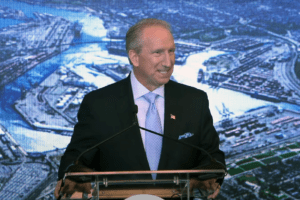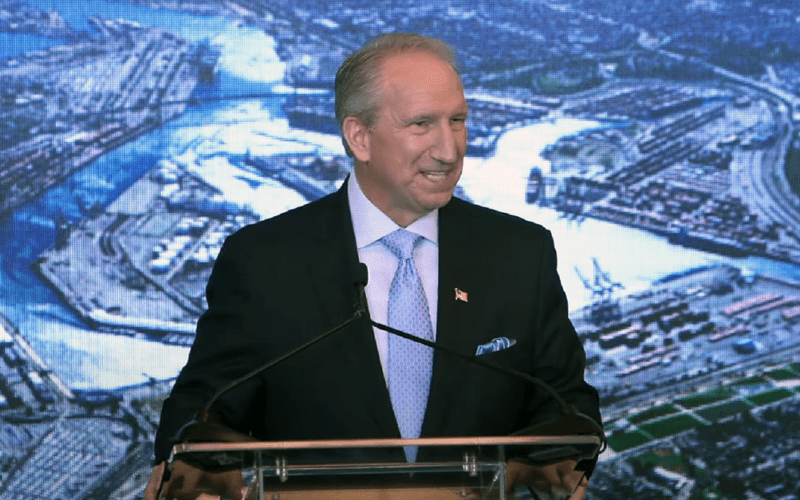
In his ninth annual ‘State of the Port’ address, given before an audience of about 550 community, business and labor stakeholders, Port of Los Angeles Executive Director Gene Seroka presented the port’s top initiatives and plans for 2024, including workforce development and improving infrastructure to handle additional cargo.
The luncheon, sponsored by the Pacific Merchant Shipping Association, was held Jan. 10 at the POLA’s World Cruise Center terminal.
During his nearly 40-minute speech and presentation, Seroka detailed, among other things, his port’s capital improvement projects and commitment to sustainability and the environment.
Regarding the port’s 10-year capital improvement program, major projects outlined by Seroka during the speech include:
- Completion this year of the port’s $73 million Pier 400 Corridor Expansion.
- Ongoing roadway, rail and site design work on the $195 million Terminal Island Maritime Support Facility.
- Final design on the $52 million on-dock railyard expansion at Pier 300 Fenix Marine Services terminal, slated to break ground in 2025.
- Seismic upgrades at the Shell Oil and PBF Energy liquid bulk facilities at the port.
Also this year, Seroka said, the port’s expected to accelerate its green hydrogen plans, bolstered by the announcement last fall of up to $300 million in federal grants funding for development of “hydrogen hub” operations in the San Pedro Bay port complex, which also includes the adjoining Port of Long Beach.
LA and Long Beach have said they plan to match the funding with up to $300 million in combined investments. LA is planning to use that funding to deploy dozens of hydrogen-powered cargo-handling equipment construction of the necessary hydrogen-fueling terminal infrastructure.
The green hydrogen investments are in addition to the 195 zero-emission Class 8 over-the-road trucks already in operation at both ports. Seroka said plans are underway to boost those numbers, in part by offering incentives under the port’s Clean Truck Fund Rate program, which has collected more than $115 million to date to help facilitate a changeover to cleaner trucks serving the port complex.
Later this year, Seroka said, the POLA’s expected to further its commitment to creating Green Shipping Corridors that focus on reducing carbon emissions along key international shipping routes through use of zero-emission trucks and terminal equipment, and gradually cleaner vessels fuels.
Five of the major ocean carriers that call on the San Pedro Bay ports will be testing lower-carbon fuels in the coming years as part of these various Green Shipping Corridor programs. To date, the Port of LA has established Green Shipping Corridor partnerships with eight ports in China, Japan, Singapore and Vietnam.
Seroka reported that in 2023 – and for the 24th straight year – the Port of LA ranked as the no. 1 container port in the U.S. When final data is available later this week, he said, the port will have processed more than 8.6 million container units in 2023, which is a decline of about 13% compared to the previous year.
However, he said, the POLA saw a strong rebound in the last five months of 2023, as well as an uptick in market share.
“The good news is that global trade is now edging up and we are looking forward to a return to more normal cargo volume levels in the year ahead,” he said.
Among the port’s ongoing and upcoming community-related initiatives are several transportation projects to ease truck and commuter traffic. For example, he said, a new Harbor Boulevard onramp and offramp upgrade between the Vincent Thomas Bridge and Harbor Freeway will break ground this year.
Seroka also reported that 219 cruises set sail from the POLA in 2023 with a record 1.3 million passengers. Each cruise generates more than $1.2 million in local payroll and business activity, according to the port.

